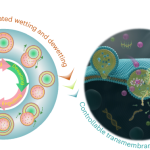Interfacial Energy-Mediated Bulk Transport Across Artificial Cell Membranes: A Game-Changer in Biotech

Introduction
Imagine a world where we can create artificial cells that can mimic the behavior of real cells. Sounds like sci-fi, right? But, with the advancements in biotechnology, we’re getting closer to making this a reality. One of the key challenges in creating artificial cells is designing membranes that can regulate the movement of molecules in and out of the cell. This is where interfacial energy-mediated bulk transport across artificial cell membranes comes into play.
What is Interfacial Energy-Mediated Bulk Transport?
Interfacial energy-mediated bulk transport is a process that occurs at the interface between two phases, such as a solid and a liquid. In the context of artificial cell membranes, it refers to the movement of molecules across the membrane, driven by the energy generated at the interface. This energy can be harnessed to transport molecules across the membrane, allowing for the creation of artificial cells that can mimic the behavior of real cells.
Interfacial Energy-Mediated Bulk Transport Across Artificial Cell Membranes: The Basics
So, how does this process work? In a nutshell, interfacial energy-mediated bulk transport involves the following steps:
- Molecule adsorption: Molecules from the surrounding environment adsorb onto the surface of the artificial cell membrane.
- Energy generation: The adsorption of molecules generates energy at the interface between the membrane and the surrounding environment.
- Transport: The energy generated at the interface drives the transport of molecules across the membrane.
The Role of Interfacial Energy in Bulk Transport
Interfacial energy plays a crucial role in the bulk transport of molecules across artificial cell membranes. The energy generated at the interface can be harnessed to drive the transport of molecules, allowing for the creation of artificial cells that can mimic the behavior of real cells.
There are several factors that can affect the interfacial energy, including:
- Surface tension: The surface tension of the membrane and the surrounding environment can affect the energy generated at the interface.
- Electrostatic interactions: Electrostatic interactions between the membrane and the surrounding environment can also impact the energy generated at the interface.
Applications of Interfacial Energy-Mediated Bulk Transport
So, what are the applications of interfacial energy-mediated bulk transport across artificial cell membranes? Some potential applications include:
- Artificial cells: Interfacial energy-mediated bulk transport can be used to create artificial cells that can mimic the behavior of real cells.
- Biotechnology: The process can be used in biotechnology applications, such as the development of new biosensors and biochips.
Challenges and Limitations
While interfacial energy-mediated bulk transport across artificial cell membranes holds promise, there are still some challenges and limitations that need to be addressed. Some of the challenges include:
- Scalability: Scaling up the process to larger systems can be challenging.
- Stability: Maintaining the stability of the membrane and the surrounding environment can be difficult.
Recent Advances in Interfacial Energy-Mediated Bulk Transport
In recent years, there have been several advances in interfacial energy-mediated bulk transport across artificial cell membranes. Some of the recent advances include:
- New materials: Researchers have developed new materials that can be used to create artificial cell membranes that can mimic the behavior of real cells.
- Improved techniques: Improved techniques, such as microfluidics and nanotechnology, have been developed to study and manipulate the interfacial energy.
Conclusion
In conclusion, interfacial energy-mediated bulk transport across artificial cell membranes is a game-changer in biotech. By harnessing the energy generated at the interface between two phases, we can create artificial cells that can mimic the behavior of real cells. While there are still some challenges and limitations that need to be addressed, the recent advances in this field hold promise for the development of new biotechnology applications.
Closing
As we continue to explore the possibilities of interfacial energy-mediated bulk transport across artificial cell membranes, we are one step closer to creating artificial cells that can revolutionize the field of biotechnology. With its potential applications in artificial cells, biotechnology, and beyond, this process is an exciting area of research that holds much promise for the future.
Interfacial Energy-Mediated Bulk Transport Across Artificial Cell Membranes: A New Frontier in Biotech
By exploring the power of interfacial energy-mediated bulk transport across artificial cell membranes, we can unlock new possibilities in biotechnology and create innovative solutions for a wide range of applications.
Harnessing the Power of Interfacial Energy
By harnessing the energy generated at the interface between two phases, we can create artificial cells that can mimic the behavior of real cells, paving the way for new discoveries and applications in biotechnology.
The Future of Biotech
As we continue to advance in interfacial energy-mediated bulk transport across artificial cell membranes, we are one step closer to creating artificial cells that can revolutionize the field of biotechnology. With its potential applications in artificial cells, biotechnology, and beyond, this process is an exciting area of research that holds much promise for the future.
Unlocking the Secrets of Interfacial Energy
By studying the interfacial energy generated at the interface between two phases, we can gain a deeper understanding of the underlying mechanisms and unlock the secrets of interfacial energy-mediated bulk transport across artificial cell membranes.
<